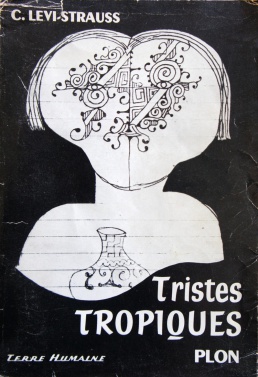
私の野蛮人―レヴィ=ストロースの『悲しき熱帯』調査
Reset
and/or Remind of Your Concepts of Cultural Anthropology

文化人類学とはなんでしょう[20分でわかる文化人類学]
太田好信・浜本満編『メイキング文化人類 学』世界思想社、2005年
そのなかで重要となる用語や概念[文化・民族・フィールドワーク・ 民族誌]
| Tristes Tropiques
(the French title translates literally as "Sad Tropics") is a memoir,
first published in France in 1955, by the anthropologist and
structuralist Claude Lévi-Strauss.[1] It documents his travels and
anthropological work, focusing principally on Brazil, though it refers
to many other places, such as the Caribbean and India. Although
ostensibly a travelogue, the work is infused with philosophical
reflections and ideas linking many academic disciplines, such as
sociology, geology, music, history and literature. The book was first
translated into English by John Russell as A World on the Wane. |
『悲しき熱帯』(フランス語のタイトルは直訳すると「悲しき熱帯」)
は、人類学者であり構造主義者でもあるクロード・レヴィ=ストロースが1955年にフランスで初めて出版した回顧録である。[1]
この本は、ブラジルを中心に、彼自身の旅と人類学的な研究を記録したもので、カリブ海やインドなど、多くの他の場所についても言及している。表向きは紀行
文であるが、この作品には哲学的な考察や、社会学、地質学、音楽、歴史、文学など、多くの学問分野を結びつけるアイデアが織り込まれている。この本は、
ジョン・ラッセルによって『A World on the Wane』というタイトルで初めて英語に翻訳された。 |
| Contents The book consists of 36 chapters, organised into nine sections. Parts 1 to 3 detail Lévi-Strauss' reflections on leaving Europe and visiting the New World and the Tropics, comparing his first impressions with subsequent visits, relating aspects of his academic training as well as his work as a professor during the founding years of University of São Paulo. Part 4 'The Earth and its Inhabitants' sets out a geographical analysis of the development of South American settlements, as well as an aside into social structure in India and what is now Pakistan and Bangladesh. Parts 5 through 8 each focus on a Native Brazilian culture group: Caduveo (or Guaycuru), Bororó, Nambikwara and Tupi-Kawahib respectively, while touching on many other topics. Part 9 'The Return' closes the book with reflections on, among other themes, the nature and purpose of anthropology, the effects of travel on the mind, the roles of Buddhism and Islam in global culture, humankind's place in the universe and our connections to the world and to one another. |
目次 本書は36章からなり、9つのセクションに分けられている。 第1部から第3部では、ヨーロッパを離れ、新世界と熱帯地域を訪れた際のレヴィ=ストロースの考察が詳細に述べられている。また、最初の印象とそれ以降の 訪問との比較、サンパウロ大学創設期における学術的訓練と教授としての仕事に関する側面についても触れられている。 第4部「地球とその住民」では、南米の入植地の地理的発展の分析と、インドおよび現在のパキスタンとバングラデシュの社会構造に関する考察が述べられてい る。 第5部から第8部では、それぞれブラジルの先住民文化グループであるカドゥベオ族(またはグアイクル族)、ボロロ族、ナンビクワラ族、トゥピ・カウィビ族 に焦点を当てているが、それ以外にも多くのトピックに触れている。 第9章「帰還」では、人類学の性質と目的、旅が心に及ぼす影響、世界文化における仏教とイスラム教の役割、人類の宇宙における位置づけ、そして世界と私た ち自身とのつながりなど、さまざまなテーマについて考察し、この本を締めくくる。 |
| Style The opening sentence, 'I hate traveling and explorers', is notable for its irony. In general, the narrative is highly reflexive, often critiquing itself or the author's and reader's assumed pretensions, such as a thirst for the 'exotic'.[2] Though the writing style is fluid, almost conversational at times, the structure of the text is extremely complex, linking together numerous places, times and ideas. For example, Part One: 'An End to Journeying' connects Lévi-Strauss' first trip to Brazil in 1935 with his escape from France to New York City in 1941 and his later visits to South America, in a stylistic imitation of memory. Lévi-Strauss frequently makes connections between ostensibly diverse entities or ideas to underline a point. For example, in Chapter 14, he compares the ancient cities of the Indus valley with those of the US in the mid-20th century, implying that Mohenjo-Daro and Harappa could be imagined as foreshadowing contemporary Chicago or São Paulo 'after a prolonged period of involution in the European chrysalis'.[3] The work maintains an elegiac and poetic tone, lamenting a 'lost' New World[4] but is tempered by a strong ambivalence, perhaps a product of the paradoxical idealized status of the anthropologist as a 'detached observer' who nevertheless remains engaged as a human participant.[5] Lévi-Strauss provides assessments of the impact of development on the environment, the 'shrinking' of the world through travel and tourism and the consequent emergence of a form of 'monoculture'. |
スタイル 冒頭の「私は旅行も探検家も嫌いだ」という一文は、その皮肉さで注目に値する。一般的に、この物語はきわめて内省的なものであり、しばしば自らや、あるい は「エキゾチック」への渇望といった、作者や読者が思い込んでいる見せかけを批判している。 文体は流暢で、会話調の箇所もあるが、テキストの構造はきわめて複雑で、数多くの場所、時代、考え方を結びつけている。例えば、第1部「旅の終わり」で は、1935年のレヴィ=ストロースのブラジルへの最初の旅と、1941年のフランスからニューヨークへの脱出、そしてその後の南米訪問が、記憶を模した 文体で結びつけられている。 レヴィ=ストロースは、ある主張を強調するために、表面的には多様な実体や考え方をしばしば結びつける。例えば、第14章ではインダス文明の古代都市と 20世紀半ばの米国の都市を比較し、モヘンジョ=ダロとハラッパーは「ヨーロッパのさなぎが長い潜伏期間を経て変態した後の」現代のシカゴやサンパウロの 都市の予兆であるかのように想像できると暗示している。 この作品は、失われた新世界を嘆く哀愁と詩情に満ちたトーンを維持しているが[4]、強い両義性によって和らげられている。おそらく、人間参加者として関 わりを持ちながらも、客観的な観察者としての理想的な立場という、人類学者の逆説的な産物によるものだろう。[5] レヴィ=ストロースは、開発が環境に与える影響、旅行や観光による世界の「縮小」、そしてその結果として生じる「単一文化」の形の出現について評価してい る。 |
| Critical reception and influence The book was well-received on its publication.[6] The organizers of the Prix Goncourt lamented that they were not able to award Lévi-Strauss the prize because Tristes Tropiques was technically non-fiction.[6] Georges Bataille wrote a favourable review[7] and Susan Sontag classed it as one of the 20th century's 'great books'.[8] |
批評家の評価と影響 この本は出版時に好評を博した。[6] ゴンクール賞の主催者は、テクスト・トリステが厳密にはノンフィクションであったため、レヴィ=ストロースに賞を授与できなかったことを嘆いた。[6] ジョルジュ・バタイユは好意的な書評を書き[7]、スーザン・ソンタグは20世紀の「偉大な本」のひとつに分類した。[8] |
| Tristes
Tropiques at the Internet Archive—full text of 1961 English
translation by John Russell |
|
| https://en.wikipedia.org/wiki/Tristes_Tropiques |
☆
『悲しき熱帯』(かなしきねったい、
フランス語: Tristes
tropiques)は、1955年にフランスで刊行された文化人類学者クロード・レヴィ=ストロースの著書である。1930年代のブラジルの少数民族を
訪ねた旅の記録をまとめた紀行文だが、その文章にちりばめられた思想、特に優れた未開社会の分析と、ヨーロッパ中心主義に対する批判により後に本書はセン
セーショナルな評価を受け、文化人類学、また構造主義におけるバイブルのひとつとなる。また人文科学にも大きな影響を与えた。終章に「世界は人間なしに始
まったし、人間なしに終わるだろう」という有名な一節がある。
また、優れた記録文学としても受容され、20世紀を代表する文学作品のひとつとしてあげられることも多い。フランスの権威ある文学賞のひとつであるゴン
クール賞を選考するアカデミー・ゴンクールは「フィクションでないために『悲しき熱帯』を受賞の対象外とされたのは、非常に残念である」との声明を出して
いる[1]。1999年の「ル・モンド20世紀の100冊」では20位。また同年、テレビ番組で行われたアンケートでは、「フランス人の選ぶ20世紀の名
作50」でも20位に選ばれている[2]。
第1部 旅の終り
第2部 旅の断章
第3部 新世界
第4部 土地と人間
第5部 カデュヴェオ族
第6部 ボロロ族
第7部 ナンビクワラ族
第8部 トゥピ=カワイブ族
第9部 回帰
[テキスト(古谷)]07making_anthroX-8.pdf
| Surtout, on s'interroge: qu'est-on venu faire ici? Dans
quel espoir? A quelle fin? Qu'est-ce au juste qu'une
enquête ethnographique? L'exercice normal d'une profession
comme les autres, avec cette seule différence que le
bureau ou le laboratoire sont séparés du domicile par
quelques milliers de kilomètres? Ou la conséquence d'un
choix plus radical. impliquant une mise en cause du
système dans lequel on est né et où on a grandi? J'avais
quitté la France depuis bientôt cinq ans, j'avais délaissé
ma carrière universitaire; pendant ce temps, mes condisciples
plus sages en gravissaient les échelons; ceux qui,
comme moi jadis, avaient penché vers la politique, étaient
aujourd'hui députés, bientôt ministres. Et moi, je courais
les déserts en pourchassant des déchets d'humanité. Qui
ou quoi m'avait donc poussé à faire exploser le cours
normal de ma vie? Etait-ce une ruse, un habile détour
destinés à me permettre de réintégrer ma carrière avec
des avantages supplémentaires et qui me seraient comptés?
Ou bien ma décision exprimait-elle une incompatibilité
profonde vis-à-vis de mon groupe social dont, quoi
qu'il arrive, j'étais voué à vivre de plus en plus isolé? Par
un singulier paradoxe, au lieu de m'ouvrir un nouvel
univers, ma vie aventureuse me restituait plutôt l'ancien,
tandis que celui auquel j'avais p~étendu se dissolvait
entre mes doigts. Autant les hommes et les paysages à la
conquête desquels j'étais parti perdaient, à les posséder,
la signification que j'en espérais, autant à ces images
décevantes bien que présentes s'en substituaient d'autres,
mises en réserve par mon passé et auxquelles je n'avais
attaché aucun prix quand elles tenaient encore à la
réalité qui m'entourait. En route dans des contrées que
peu de regards avaient contemplées, partageant l'existence
de peuples dont la misère était le prix - par eux
d'abord payé - pour que je puisse remonter le cours de
millénaires, je n'apercevais plus ni les uns ni les autres,
mais des visions fugitives de la campagne française que je
m'étais déniée, ou des fragments de musique et de poésie
qui étaient l'expression la plus conventionnelle d'une
civilisation contre laquelle il fallait bien que je me persuade
avoir opté, au risque de démentir le sens que
j'avais donné à ma vie. Pendant des semaines, sur ce
plateau du Mato Grosso occidental, j'avais été obsédé,
non point par ce qui m'environnait et que je ne reverrais
jamais, mais par une mélodie rebattue que mon souvenir
appauvrissait encore: celle de l'étude numéro 3, opus 10,
de Chopin, en quoi il me semblait, par une dérision à
l'amertume de laquelle j'étais aussi sensible, que tout ce
que j'avais laissé derrière moi se résumait.
|
何よりも、私たちは疑問に思う:な
ぜここに来たのか?何の希望を持って?何のために?民族誌調査とは一体何なのか?他の職業と同じように、オフィスや研究室が自宅から数千キロ離れていると
いう違いだけのある、通常の職業活動なのか?それとも、より根本的な選択の結果なのか。自分が生まれ育ったシステムそのものを疑問視する選択なのか?私は
フランスを離れてからほぼ5年が経ち、大学でのキャリアを捨てた。その間、同級生たちはより賢明な道を選び、出世の階段を登っていた。かつて私と同じよう
に政治に傾倒していた者たちは、今では国会議員となり、間もなく大臣になる者もいた。そして私は、人間の残骸を追いかけて砂漠を駆け回っていた。一体誰
が、何が、私の人生を通常のコースから外れさせたのか?それは、将来的に追加の利益を得てキャリアに復帰するための巧妙な策略だったのか?それとも、私の
決断は、何があってもますます孤立して生きていく運命にある私の社会集団との深い不適合を反映していたのか?奇妙なパラドックスによって、私の冒険的な人
生は、新しい世界を開くどころか、むしろ古い世界に戻し、私が手に入れたはずの世界は、私の指の間から消えていった。私が征服しようとした人々や風景は、
手に入れた途端に私が期待していた意味を失った一方で、その失望に満ちたイメージの代わりに、私の過去が蓄えていた、現実の世界に属していた時には何の価
値も感じなかったイメージが浮かび上がってきた。ほとんど誰も見たことのない土地を旅し、その人々の悲惨な生活(彼らが最初に支払った代償)によって、私
が数千年の時を遡ることができるように、
私はもはや彼らも、その風景も目に入らなかった。代わりに、私が否定してきたフランスの田園風景の断片や、音楽と詩の断片が浮かび上がった。それらは、私
が自分の人生に与えた意味を否定するリスクを冒してでも、自分が選択したと自分に言い聞かせなければならない文明の最も一般的な表現だった。数週間、マ
ト・グロッソ西部の高原で、
私は、周囲の世界や二度と見ることはないであろう風景ではなく、記憶がさらに薄れつつある、繰り返し聴いたメロディに執着していた。それは、ショパンの
「練習曲(エチュード)第3番、作品10」で、その苦い皮肉に私は敏感に反応し、自分が残してきたすべてのものがそこに凝縮されているように感じた。 |
| Claude Levi-Strauss, 1908-2009, 1955. Tristes Tropiques, Plon 版1957年 Pp.450-451. |
+++++
リンク
文献
その他の情報
Copyleft, CC, Mitzub'ixi Quq Chi'j, 1996-2099

Copyleft, CC, Mitzub'ixi Quq Chi'j, 1996-2099
☆
 ☆
☆